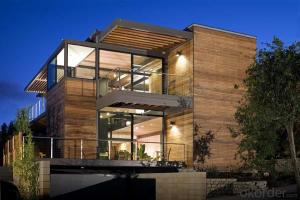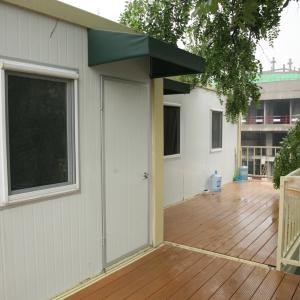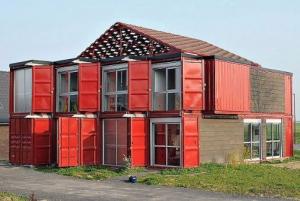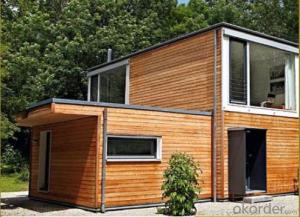Prefab Container Cabin with Modern Design
- Loading Port:
- Shanghai
- Payment Terms:
- TT OR LC
- Min Order Qty:
- 1 m²
- Supply Capability:
- 10000 m²/month
OKorder Service Pledge
OKorder Financial Service
You Might Also Like
Affordable Prefab House;light steel structure prefab houses
light steel structure prefab house Space
Container house is real boring like a box. Although we did lot of work on it with insulation, interior and exterior decoration, it seems still a box. And with the decorative layers, the original small space inside to be more narrow (2.13m to be 2.0m), how could we turn around in our living room with sofa and TV…
From now on, breaking the constraint of the size, enjoy the big space and high quality life in our cabin. (3.0m * 5.8m rooms).
Assembly
You are not superman, the first and big problem you worried about is how to assembly? You buy a prefab house with tanglesome package, scattered parts on the ground... I cannot imagine your agony.
It is more easier and faster with Steelvilla cabin, only 10 steps like the IKEA furniture. No heavy work, no special tools, no technician, and no crane required.
Delivery
If the 20 feet or 40 feet container house, cannot be packaged. Hard to deliver.
Steelvilla cabin is with flat package, easy to load and unload. Fast-Assembly technology makes things are much easier.
Appearance
Container house is container that is truth. No one can change.
SteelVilla cabin is with high standard design, it looks modern and it is practicable.
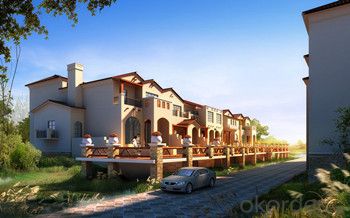
- Q:Are container houses susceptible to rust or corrosion?
- Container houses, typically constructed from steel shipping containers, are designed to endure the harsh conditions of long-distance sea transportation. These containers are predominantly made from weathering steel or corten steel, renowned for their exceptional resistance to corrosion. Though container houses possess a general resistance to rust and corrosion, it is crucial to acknowledge that they are not entirely impervious to these issues. Over time, without proper maintenance or exposure to specific environmental elements, rust and corrosion may manifest. Several factors can contribute to rust and corrosion in container houses, such as exposure to moisture, salty air, and extreme weather conditions. Inadequate sealing of the containers can result in water seepage, leading to rust formation. Furthermore, damaged or worn-out paint or protective coatings on the containers may cause corrosion. To mitigate the risk of rust and corrosion in container houses, regular maintenance is imperative. This entails inspecting the containers for any signs of damage or wear, rectifying cracks or holes, and applying necessary protective coatings or paint. Proper sealing of the containers and ensuring adequate ventilation can also assist in preventing moisture buildup and minimizing the risk of rust. In conclusion, while container houses are generally resistant to rust and corrosion, they are not entirely impervious. By implementing proper maintenance and care, the likelihood of rust and corrosion can be minimized, safeguarding the longevity and durability of the container house.
- Q:Can container houses be designed with a modern coworking space?
- Yes, container houses can definitely be designed with a modern coworking space. Container houses are known for their versatility and adaptability, making them an ideal choice for creating unique and innovative spaces. With proper planning and design, container houses can be transformed into stylish coworking spaces that offer all the amenities and functionality required by modern professionals. One of the main advantages of container houses is their modular nature. This allows for easy customization and expansion, making it possible to create separate sections within the container for different purposes. By utilizing the available space efficiently, a container house can accommodate private offices, shared workspaces, meeting rooms, and even recreational areas. In terms of design, container houses can be made to look sleek and contemporary, aligning perfectly with the aesthetics of a modern coworking space. The exterior can be painted in vibrant or minimalist colors, while the interior can be designed with modern furniture, ergonomic workstations, and ample natural light. Creative and functional storage solutions can also be incorporated to maximize the use of space. Furthermore, container houses can be equipped with all the necessary facilities and amenities for a coworking space. This includes high-speed internet connectivity, shared printers and scanners, communal kitchen areas, and comfortable common spaces for networking and collaboration. It is also possible to install eco-friendly features such as solar panels, rainwater harvesting systems, and energy-efficient appliances, aligning with the sustainability goals often associated with modern coworking spaces. Overall, container houses offer a unique and cost-effective solution for creating a modern coworking space. Their adaptability, versatility, and customizable nature make them an attractive choice for entrepreneurs and businesses looking for a trendy and functional workspace.
- Q:Can container houses be designed with a balcony or patio?
- Yes, container houses can be designed with a balcony or patio. While containers themselves do not typically come with balconies or patios, they can be modified and customized to include these features. Balconies and patios can be added to container houses by extending the structure or creating platforms that provide outdoor living spaces. This allows homeowners to enjoy the benefits of outdoor living, such as fresh air, sunlight, and a space to relax or entertain guests. Additionally, the design of the balcony or patio can be tailored to meet the specific aesthetic preferences and functional needs of the homeowner, making container houses a versatile and customizable option for those who desire outdoor living spaces.
- Q:Can container houses be designed with a high ceiling?
- Certainly! Container houses have the potential to incorporate a high ceiling into their design. Their versatility allows for customization to cater to various design preferences, including the desire for a lofty interior. The specific height of the container house's ceiling hinges upon the modifications and design choices made during the conversion process. By either removing portions of the original roof or incorporating extension components, one can elevate the ceiling height, resulting in a spacious and airy atmosphere. Furthermore, container houses can integrate diverse roof types, such as gable or shed roofs, which further contribute to an increased ceiling height. Ultimately, with the proper modifications and design considerations, container houses can indeed possess a lofty ceiling.
- Q:Are container houses suitable for permanent or temporary living?
- Depending on individual needs and preferences, container houses are versatile for both permanent and temporary living. For temporary living, they provide a cost-effective and flexible solution. They can be easily transported and set up in different locations, making them ideal for those who frequently move or require temporary accommodations, such as construction sites or disaster relief efforts. Alternatively, container houses can also be suitable for permanent living. With proper insulation, plumbing, and electricity installations, they can offer all the necessary amenities for a comfortable and functional home. Individuals or families can customize them to their specific requirements and aesthetic preferences, creating a unique living space. Container houses have several advantages for permanent living. They are environmentally friendly, repurposing used shipping containers and reducing environmental impact. Additionally, they are often more affordable than traditional houses, making homeownership accessible to a wider range of people. However, it is important to consider potential limitations of container houses for permanent living. The limited size of shipping containers may pose challenges for larger families or those who require more space. Modifying containers to meet building codes and regulations may also incur additional costs and time. Furthermore, the industrial look of container houses may not appeal to everyone's aesthetic preferences. In conclusion, container houses offer cost-effectiveness, flexibility, and eco-friendliness, making them suitable for various living situations. However, it is crucial to carefully consider the specific requirements and limitations before deciding on their suitability for a particular living arrangement.
- Q:Are container houses suitable for artist residencies or creative spaces?
- Yes, container houses can be suitable for artist residencies or creative spaces. Their modular and customizable nature allows for easy adaptation to specific artistic needs. They are cost-effective, eco-friendly, and can be quickly assembled or disassembled, making them perfect for temporary or mobile creative spaces. Additionally, container houses provide a unique and contemporary aesthetic that can inspire and enhance artistic work.
- Q:Can container houses be transported overseas?
- Indeed, container houses possess the capability to be transported across oceans. Their modular and stackable structure grants them excellent portability, facilitating effortless loading onto ships for international shipping. The containers employed in constructing these houses are specifically engineered to withstand harsh sea conditions and conform to global shipping standards, rendering them suitable for long-distance transportation. Moreover, container houses possess the advantage of being easily dismantled and reassembled at their final destination, enabling convenient relocation and adaptability. Nevertheless, it is crucial to take into account the logistical aspects and expenses associated with overseas transportation, encompassing shipping charges, compliance with customs regulations, and any obligatory permits or approvals mandated by the destination country.
- Q:Can container houses be designed with an open floor plan?
- Certainly, an open floor plan can indeed be incorporated into container houses. In actuality, the modular quality of shipping containers renders them an optimal selection for crafting open and versatile living areas. Through meticulous planning and design, containers can be altered and combined to produce roomy and expansive interiors that cater to the preferences of homeowners. Container homes have the potential to possess extensive, unobstructed living spaces that seamlessly link various functional areas like living rooms, dining areas, and kitchens. This open floor plan enables better flow and utilization of space, thereby imparting a greater sense of spaciousness and warmth to the container house. One of the benefits of container houses is the capacity to eliminate interior walls or create sizable openings in order to maximize natural light and augment the sensation of openness. This can be accomplished by utilizing glass walls, skylights, or strategically positioning windows. By doing so, container homes can be bathed in natural light, further enhancing the ambiance of openness and airiness. Moreover, container houses can be tailored to incorporate additional features that facilitate an open floor plan, such as sliding doors, foldable partitions, or multi-functional furniture. These elements bestow flexibility upon the layout, enabling homeowners to easily adapt the space to their evolving requirements. To summarize, container houses are supremely adaptable and can be designed with open floor plans that offer a spacious and flexible living experience. By making the right design decisions and implementing modifications, container homes can generate a modern and inviting atmosphere while optimizing the available space.
- Q:What are the common challenges faced during the construction of container houses?
- There are several common challenges that can be encountered during the construction of container houses. Firstly, one of the main challenges is ensuring proper insulation and ventilation. Containers are primarily designed for cargo transportation and may not have sufficient insulation or ventilation systems in place. This can lead to issues with temperature regulation and air quality within the container house, requiring additional measures to be taken to address these concerns. Secondly, structural modifications may be necessary to create openings for doors, windows, and other necessary amenities. Containers are built to be structurally sound for shipping purposes, but cutting openings for windows and doors can weaken the structure. Therefore, proper reinforcement and structural engineering expertise are crucial to maintain the structural integrity of the container while creating functional living spaces. Thirdly, plumbing and electrical installations can pose challenges in container houses. Containers are not originally designed to accommodate plumbing and electrical systems, so careful planning and expertise are necessary to ensure the safe and efficient installation of these utilities. Additionally, limited space within the containers can make it more challenging to route and conceal plumbing and electrical lines. Another challenge is complying with building codes and regulations. Container houses may be subject to the same regulations as traditional houses, and obtaining the necessary permits and approvals can be a complex process. It is essential to work closely with local authorities and ensure that the construction follows all applicable building codes to avoid any legal issues. Lastly, transportation and logistics can be a significant challenge during the construction of container houses. Containers are large and heavy, and their transportation to the construction site may require specialized equipment and careful planning. Additionally, coordinating the delivery of multiple containers and ensuring they are properly aligned and secured on-site can be a logistical challenge. Despite these challenges, container houses offer unique advantages such as cost-effectiveness, sustainability, and flexibility in design. With proper planning, expertise, and attention to detail, these challenges can be overcome, resulting in a well-built and functional container house.
- Q:Can container houses be designed with a walk-in closet or dressing room?
- Yes, container houses can definitely be designed with a walk-in closet or dressing room. One of the advantages of using shipping containers for housing is their versatility and ability to be customized according to individual needs and preferences. With the right planning and design, it is possible to incorporate a walk-in closet or dressing room into a container house. While space may be limited compared to traditional houses, creative utilization of the available area can help optimize the design. For example, the walk-in closet can be designed to make the most of vertical space by incorporating shelving, hanging racks, and storage solutions that maximize storage capacity. Additionally, using sliding or folding doors can help save space and make the most of the available area. The design of the container house can also be adjusted to accommodate a dressing room. By strategically placing a mirror and vanity area, it is possible to create a separate space for getting ready and applying makeup. This can be achieved by partitioning off a section of the container or by utilizing a separate container module solely for the purpose of a dressing room. Ultimately, the feasibility of having a walk-in closet or dressing room in a container house depends on factors such as the overall design, size of the container, and the specific needs and preferences of the homeowner. However, with proper planning and customizations, it is certainly possible to have a functional and stylish walk-in closet or dressing room within a container house.
1. Manufacturer Overview |
|
|---|---|
| Location | |
| Year Established | |
| Annual Output Value | |
| Main Markets | |
| Company Certifications | |
2. Manufacturer Certificates |
|
|---|---|
| a) Certification Name | |
| Range | |
| Reference | |
| Validity Period | |
3. Manufacturer Capability |
|
|---|---|
| a)Trade Capacity | |
| Nearest Port | |
| Export Percentage | |
| No.of Employees in Trade Department | |
| Language Spoken: | |
| b)Factory Information | |
| Factory Size: | |
| No. of Production Lines | |
| Contract Manufacturing | |
| Product Price Range | |
Send your message to us
Prefab Container Cabin with Modern Design
- Loading Port:
- Shanghai
- Payment Terms:
- TT OR LC
- Min Order Qty:
- 1 m²
- Supply Capability:
- 10000 m²/month
OKorder Service Pledge
OKorder Financial Service
Similar products
New products
Hot products
Related keywords
